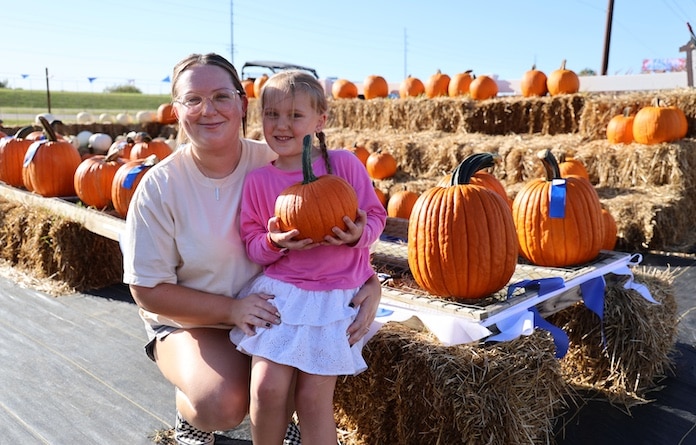The pride of pumpkin farming

Fall officially began Sept. 22, but many don’t feel like it’s truly autumn until they start seeing Halloween decorations, leaves changing color or the true seasonal staple of pumpkins.
When it comes to pumpkin production in the United States, Illinois stands out by a significant margin.
Data from the Economic Research Service of the U.S. Department of Agriculture notes that Illinois harvests more pumpkins than the five other highest states – California, Indiana, Michigan, Pennsylvania and Virginia – combined.
This is primarily due to the state containing two major pumpkin processing plants with Nestle Libby and Seneca Foods.
The USDA data thus also points out Illinois produces a tremendous amount of processed pumpkins – such as those used in pie filling – while the other leading states mainly focus on fresh pumpkins.
Of course, Illinois still harvests plenty of fresh pumpkins in time for fall, as demonstrated by a number of local farmers who are currently making sure Monroe County’s pumpkin pie, pumpkin seeds and jack-o’-lantern needs are met through the season.
Within the county, two of the largest farm families providing pumpkins are the Stuckmeyers and Johannings.
Nathan Johanning spoke about his experience as a local pumpkin farmer. He said his interest in farming began as he was raised around his grandparents’ farm.
He later received bachelor’s and master’s degrees in plant and soil science from Southern Illinois University Carbondale.
Johanning currently works as a commercial agriculture educator at the Monroe County University of Illinois Extension. He also rents out some of his acreage for grain production, though his farming focus seems to be placed on pumpkins.
As he described, he starts pumpkin production in early June. With a somewhat unique operation, he transplants live plants rather than planting seeds directly, letting them get started in large flats for two weeks and then moving them with a mechanical transplanter.
With about five acres dedicated to pumpkin growing, the Johannings grow about 7,000 plants each year.
Around mid or late-June, the pumpkins start to grow fairly quickly.
“They sit there, and all of a sudden, they vine out and grow massively just like the plants that come up in people’s flower beds where they have pumpkins that just take over their yard almost,” Johanning said.
Harvesting begins in mid-September and continues through mid-October, though demand naturally tends to wind down as Halloween hits.
When it comes to evaluating the quality of his crop, Johanning noted size was the primary factor to consider, though he also mentioned that the family grows around 70 different varieties of pumpkins ranging from those that can grow especially big to others that are more humble gourds.
As far as this year’s harvest quality, Johanning explained that a rather dry August didn’t help the growing, and thus the early harvest resulted in some smaller fruit.
Fairer weather more recently has helped, however, as Johanning said he’s seen a bit of a rebound since early September.
“Somewhere in the early part of September we started to get a little bit of rain, and that’s definitely perked things up,” Johanning said. “It doesn’t completely recover things, but it does help and improve the size.”
Related to quality concerns, Johanning noted a number of external factors such as diseases and insect pests he takes precautions for.
He particularly emphasized the trouble animals like deer and voles can cause.
Deer tend to wander into the field and take sizable bites out of the pumpkins as they’re growing, leaving scars or large holes in the fruit.
Voles and other small critters like to go down a row of pumpkins and munch away as the summer starts wrapping up.
“Voles are really prevalent,” Johanning said. “They really come out as it starts to get closer to the cooler days. They’ll go, and they’ll just start chewing on pumpkins. Yesterday I picked a few, and I picked them up, and the whole face-down side was just all chewed up by mice, and obviously at that point, it’s not marketable.”
Even with the difficulties animals and pests can provide, Johanning seemed pleased with his current harvest this year.
“Overall this season has been pretty good,” Johanning said. “Some of the wildlife, you kinda just know that you’re gonna share. They’re gonna get a few, hopefully you get more than they get.”
Johanning also discussed some of the particulars of farming pumpkins as opposed to the regional staple grains of corn, wheat and soybeans.
Along with the fact each fruit is harvested by hand, there are also considerable differences in how the crops get sold.
“The level of work and management of it is completely different in many ways,” Johanning said. “It’s still growing a crop, and you have similar tests, but on the marketing side, we don’t have any elevators that we market to for pumpkins. The markets that I have developed over the last 18-20 years… You can’t just grow five acres of pumpkins and expect to just find a place to sell them to.”
Along with the larger operations of the Johannings and Stuckmeyers, Monroe County also has a number of smaller pumpkin-growing operations, though a number are still larger than families simply cultivating a pumpkin patch in their yard.
Joel Becker and his family operate a small pumpkin stand in Burksville Station each year.
He gets started around Father’s Day each year, taking a few days to get planting done with a makeshift corn planter. He previously did the work by hand.
With good moisture, Becker starts to see some sprouting just a few days later, and a couple weeks after that, the buds arrive and he starts really wishing for good rain.
“After about eight weeks or so, you’ll start seeing flowers and everything, and that’s when your fruit really starts growing,” Becker said. “The bees are working as your pollinators, you’ve got male and female flowers.”
Becker spoke about some other particulars of his operation – which he manages on top of working as a carpenter – including struggling with weeds during drier years or runoff troubles stemming from planting on a hill.
He also noted the varieties grown, noting how interesting it is to see how different each can be. A Mellow Yellow variety, which is the same size as a typical pumpkin but is a more distinct yellow, received a particular mention.
David Huebner is another pumpkin-growing local who does his work as more of a hobby. He also has a stand along Kaskaskia Road near Burksville.
Growing around 2,000-3,000 pumpkins each year, he began growing them with his kids and has continued to do so for years now, also providing them for his wife who owns Bountiful Blossoms in downtown Waterloo.
Huebner spoke to the satisfaction that comes from providing this fall fixture for friends, family and other locals.
His stand features a bit of a photo op with a tractor and hay bales. As he described, a number of people stop by for pictures or otherwise visit the stand each year.
“It’s just a hobby, really,” Huebner said. “We started doing it with the kids, and it’s kind of continued on. Everybody comes out and says they really like coming out here.”
Likewise, Johanning – who offloads his pumpkins to several local businesses as well as events such as Waterloo Pumpkinfest and a recent stop at the Monroe County Farmers Market – also spoke about the pleasure of selling pumpkins to local families.
“I’m really honored to have a chance to provide pumpkins to all kinds of people,” Johanning said. “I have kids young and old that come up. Some of the ‘old’ kids that come up for pumpkins get almost just as crazy as the young ones.”
Becker, too, spoke about how nice it is to contribute to the start of the holiday season for so many people, with his stand also serving as a photo op and seasonal stop for many each year.
“People have come out for eight years or so we’ve been doing it,” Becker said. “They’ve made a family event out of it. I’ve had people show up with a minivan full of a bunch of kids. They seem like they really enjoy it, and that’s more or less what keeps me doing it.”






